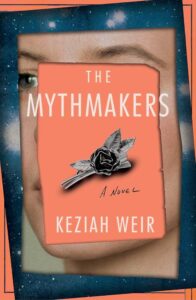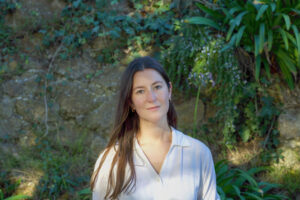Artists’ egos → artist psychodrama
The Mythmakers
by Keziah Weir
Toronto: McClelland & Stewart, 2024
$24.00 / 9780771000294
Reviewed by Jessica Poon
*

The Mythmakers, the debut novel by Salt Spring Island-raised Keziah Weir, is a captivating, well-written novel with plenty of flashbacks and a plot twist whose satisfying cleverness is not hinged on unprecedented, you-never-would-have-guessed-it sneakiness, but rather, a twist whose effectiveness is contingent on truly understanding the characters’ psychologies and predilections for alteration, machination, and mythologizing.
Sal, short for Salale, is a dissatisfied writer in New York who reads a short story by Martin Keller in The Paris Review, only to recognize herself in a character—the girl with the barrette. An older man with a much younger woman as a muse is a tale so ancient there are probably hieroglyphics of the phenomenon; however, mercifully, Martin does nothing lascivious during his one-time encounter with Sal. They mostly talk about books—it’s all very wholesome, and Martin guesses that Sal is a writer.
After reading the short story, though, Sal learns that Martin has died. Helpfully, his posthumous author bio makes plain that he used to be divorced—whether dissolved marriages typically make the cut for a notoriously succinct genre of prosaic, achievement-centric writing, I somehow doubt—and that he was working on a novel before he died.

When Sal loses her job and accuses her long-term boyfriend, Hugh, of infidelity, the life she was somewhat tepid about seems perceptibly worse. Of course, blighted career and romantic prospects mean it’s time to usher in voluntary chaos. Martin’s work-in-progress inspires Sal to do what any stultified, reasonably narcissistic writer in an ambiguously over-romantic relationship might do: Sal decides to get her hands on Martin’s incomplete novel.
With the help of an editor, Sal decides to find Moira, an astronomer who lives in a small town named Linden. Since this is a novel and people like talking about themselves, Moira is surprisingly forthcoming with very personal details about her life, though not all at once. In this way, Sal learns about Moira and Martin’s marriage; their daughter, Caroline, a pianist in California; Wesley, Martin’s longtime friend; and Lillian, Martin’s first wife. Along the way, Sal befriends Sawyer, a barista struggling with their PhD. Sal’s decision to learn more about Martin, though, proves far different and more complex than anything she could have imagined. To learn the biography of one person entails the accumulation of so many other biographies. To learn the biography of someone else is to enact your own myth-making.
The novel alternates from Sal’s first-person voice to the supporting characters in third-person. There are stories within stories and alternating accounts of the same phenomena. Though Sal, ostensibly the protagonist, seeks to discover more about Martin, both Sal and Martin are easily eclipsed by both of Martin’s wives, Lillian and Moira. Sal is perfectly serviceable, but the most interesting thing about her is her intense interest in others—which, perhaps, is why she’s a writer, one prone to unflattering judgements. For instance, Sal’s apparent disgust at Hugh, for settling for financial security over fulfilling lofty artistic dreams, is likely more projection than actual contempt.
Martin became an author during an era before everyone and their mother had an MFA, the kind of autodidact CV more formally credentialed authors fantasize over. All that being said, Martin certainly enjoyed cronyism. To see Moira as a young girl with a natural affinity for science; then as a young woman, intimidated by Lillian, is an effective contrast to present-day Moira, a respected scientist and loving mother (and, now, widow). Caroline’s prominence in the second half of the novel struck me as a somewhat puzzling choice, though her former relationship with a violinist, Julia, demonstrate the intra-competitiveness that naturally occurs between artist couples, as well exemplifying the stereotypical congeniality, post-breakups, between queer women.
Though the novel is neither a traditional detective story nor a thriller, the ongoing discoveries and displacements are reminiscent of those genres, but with a rarefied literary focus that makes for a worthwhile page turner—no blood or murder necessary, just artistry and pathos. Don’t let its length fool you; this is a quick read.
*

Originally from East Vancouver, Jessica Poon is a writer, former line cook, and pianist of dubious merit who recently returned to BC after completing a MFA in Creative Writing at the University of Guelph. [Editor’s note: Jessica Poon has reviewed books by Amber Cowie, Robyn Harding, Roz Nay, Anne Fleming, Miriam Lacroix, Taslim Burkowicz, Sam Wiebe, Amy Mattes, Louis Druehl, Sheung-King, Loghan Paylor, Lisa Moore (ed.), Sandra Kelly, Robyn Harding, Ian and Will Ferguson, Christine Lai, Logan Macnair, Jen Sookfong Lee, J.M. Miro (Steven Price), Bri Beaudoin, Tetsuro Shigematsu, Katie Welch, Megan Gail Coles, and Ayesha Chaudhry for BCR]
*
The British Columbia Review
Interim Editors, 2023-25: Trevor Marc Hughes (non-fiction), Brett Josef Grubisic (fiction and poetry)
Publisher: Richard Mackie
Formerly The Ormsby Review, The British Columbia Review is an online book review and journal service for BC writers and readers. The Advisory Board now consists of Jean Barman, Wade Davis, Robin Fisher, Barry Gough, Hugh Johnston, Kathy Mezei, Patricia Roy, Maria Tippett, and Graeme Wynn. Provincial Government Patron (since September 2018): Creative BC. Honorary Patron: Yosef Wosk. Scholarly Patron: SFU Graduate Liberal Studies. The British Columbia Review was founded in 2016 by Richard Mackie and Alan Twigg.
“Only connect.” – E.M. Forster
2 comments on “Artists’ egos → artist psychodrama”